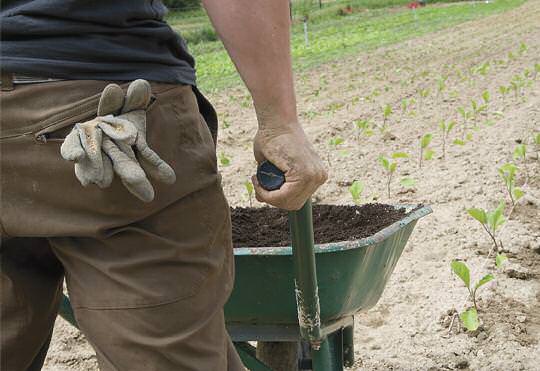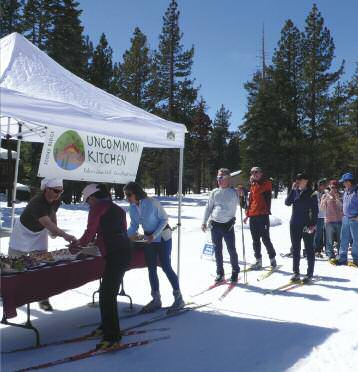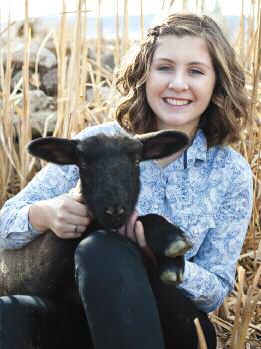LEADERSHIP THROUGH LAMBS
4-H teaches kids life and animal skills.
GROWING FARMERS
Cooperative Extension program supports new agricultural endeavors.
SKI FOR FOOD
Eat and stride at Gourmet Ski Tour.
GLOBAL CUISINE
Delight in international tastes at Night of All Nations.
FOUNTAIN SPRINGS
Local company exemplifies spirit of innovation.
LEADERSHIP THROUGH LAMBS
4-H teaches kids life and animal skills.
WRITTEN BY MARNIE McARTHUR
PHOTO BY CANDICE NYANDO
|
Evelyn Cunningham, 17, poses for a portrait with a one-month-old baby lamb, not yet named, at a Reno farm |
“I pledge my head to clearer thinking, my heart to greater loyalty, my hands to larger service, and my health to better living — for my club, my community, my country, and my world.” — 4-H Pledge
Evelyn Cunningham never dreamed she would spend her high school years raising and showing lambs. The sociable Reno High School senior is a city girl. Farm animals were not a part of her life. The only family pet is a five-pound teacup poodle named Andy.
“My mom and brother are allergic to everything, but I’ve always loved being around animals,” Cunningham says.
Her venture into 4-H was a happy accident. Cunningham’s parents attended Wooster High School where their math teacher was Joni Test, a co-founder of 4-H in Reno. Test later became a family friend who encouraged the girl to join. From fifth grade through high school, commitment to 4-H has been a major factor in her success as a straight-A student bound for a New York City college.
The Reno club — called Leg of Lamb, Side of Beef, Slab of Bacon — is the largest in Nevada, serving about 50 kids each year and nearly 800 since its beginning in 1991. A majority of them choose to raise lambs.
“There’s a lot to learn and do with lambs,” Cunningham says. “Few have strong personalities and they aren’t very smart, so you have to spend a lot of time and work hard to get them ready for show. The animals can feel if you’re worried. I’ve learned to stay really calm.”
Each club member keeps a record book on their animal and details community service activities as well.
“4-H is about helping in your community,” Cunningham says. “It’s also a lot of fun. Most kids are shy and nervous when they start. The older kids help the younger ones.”
Finding buyers for their animals before the Nevada Junior Livestock Show is an important lesson learned by all 4-H kids. Everyone is taught that these are market animals not pets, but they still give them names.
“I remember the names of all my lambs,” Cunningham says. “One in particular, Derek Zoolander, was the coolest. He had a strong personality, and he worked really well with me. We had a lot of bonding during the show, and I won the Senior Showmanship Award with him in 2009.”
Eight years in 4-H (ending with election as club president in her final year) have given Cunningham self-confidence, organizational skills, poise in public speaking, and a pattern for public service.
“4-H gives us a lot,” she says.
Marnie McArthur is a Reno freelance writer who has never lived on a farm. She loves animals
Resources and Events
Leg of Lamb, Side of Beef, Slab of Bacon 4-H Club
Reana Bye, 775-224-4108
Joni Test, 775-852-5597
April 22
Washoe County Junior Livestock Show
Reno Livestock Events Center
Cindy Smullen, Washoe County Cooperative Extension, 775-784-4848
May 17 – 20
Nevada Junior Livestock Show
Reno Livestock Events Center
Doris Hoskin, 775-790-4600, www.Agri.nv.gov/ADMIN_JrLivestock.htm
Nevada 4-H
UNR Cooperative Extension
Www.unce.unr.edu/4H/contact/personnel/
Future Farmers of America
www.Facebook.com/pages/Nevada-FFA/121969314504624
GROWING FARMERS
Cooperative Extension program supports new agricultural endeavors.
WRITTEN BY JIM SLOAN

With more than 60 percent of United States farmers being over the age of 55, federal agriculture officials have been scrambling in recent years to find ways to bring new faces to the farm.
But even if you can entice people to turn in their white collars and laptops for tractors and compost, how can you be sure they’ll succeed in an industry where a year’s profit can be wiped out by insects, drought, or windstorm?
That’s where University of Nevada Cooperative Extension’s new Beginning Farmer and Rancher program comes in. This three-year program kicks off this year with a series of workshops designed solely to help less-experienced farmers and ranchers learn both the business and agricultural production sides of their chosen professions.
“Farmers and ranchers already face some pretty steep odds against success,” says Staci Emm, a Mineral County extension educator who is helping launch the new initiative. “This program will give them the support they need.”
Beginning farmers and ranchers are defined as individuals who have been involved in agriculture for fewer than 10 years. They could include a spouse or an offspring who is starting work on a long-standing family farm or even a longtime farmer or rancher who is diversifying his or her operation.
The first year’s program will include workshops on field crops, such as alfalfa and grass hay; locally grown meat products, including lamb, beef, and poultry; and vegetable farming. Classes will be held in extension office sites around the state starting in March and continuing into the fall.
“Everyone in Nevada wins when we can trace the origin of our agriculture products,” says Lyon County Extension Educator and Area Director Loretta Singletary. “It helps Nevada producers ensure that our state can feed itself and that purchasing power stays in our state.”
For details about University of Nevada Cooperative Extension’s Beginning Farmers and Ranchers program, visit Www.unce.unr.edu.
Jim Sloan is a communications specialist with University of Nevada Cooperative Extension.
SKI FOR FOOD
Eat and stride at Gourmet Ski Tour.
WRITTEN BY MELISSA SIIG
PHOTO COURTESY TAHOE CROSS COUNTRY SKI AREA

Who says exercising has to be all about burning calories? At the Gourmet Ski Tour, you can refuel and ski at the same time. The tour, which is in its 11th year, is held at the Tahoe Cross Country Ski Area in Tahoe City the second Sunday of every March, which this year is March 11. The event features about 20 local restaurants doling out food samples, appetizers, and cups of soup in a large meadow. Participants can ski, snowshoe, or walk (depending on conditions) to each booth, although Event Coordinator Patti Lovely recommends snowshoeing.
“Skis get in the way when you want to belly up to the booth, and you definitely don’t want poles,” she says. “It makes it hard to hold a plate.”
The restaurants include such Tahoe favorites as Mamasake, Bridgetender, Sunnyside, Wolfdale’s Cuisine Unique, and Christy Hill, as well as local wine from Truckee River Winery. A kids station has hamburgers and hot dogs and an obstacle course. The tour, which runs from 1 to 3 p.m., ends with dessert in the yurt, as well as margaritas and dancing to local band Drunken Neighbors.
The tour is a fundraiser for the Tahoe Cross Country Ski Education Association, a nonprofit organization whose mission is to promote the sport of cross-country skiing through educational activities for children and adults.
The event has become a popular annual affair, usually selling out of its 300 tickets.
But don’t worry — you don’t need to be an expert Nordic skier to enjoy the tour; it’s really more of a social event, Lovely says.
“It has nothing to do with real exertion,” she says. “It’s more about eating.”
Tickets are $30 for adults, $25 for ages 13-17, and free for kids 12 and under. Tickets are discounted for season pass holders. To order tickets, call 530-583-5475 or visit www.Tahoexc.com.
Melissa Siig is a freelance writer based in Tahoe City, Calif. She enjoys skate skiing at the Tahoe Cross Country Ski Area, but has never tried eating and skiing at the same time.
GLOBAL CUISINE
Delight in international tastes at Night of All Nations.
WRITTEN BY AMY HARRIS
PHOTO BY JEFF DOW

Traditional Iranian potato salad, Vietnamese spring rolls, Chilean empanadas filled with sausage and potato, and Taiwanese tea are just a sampling of the variety of foods at the annual Night of All Nations. The International Club at the University of Nevada, Reno, organizes the event each April, drawing up to 4,000 people. Students from more than 22 countries prepare and serve food, while others belly dance, spin fire, dance flamenco, play music, or sing.
“There are over 74 countries represented at UNR,” says Eric Rios, the executive vice-president of the International Club. “Over 50 of those countries are represented at the event. It’s a great place for people to become global citizens.”
This year marks the 30th annual Night of All Nations. The event is a visual illustration of diversity, with African fabric, clothing, and art displayed on one table; a Korean martial arts performance on stage; and Native American atole, or blue cornmeal, served at another table.
“After people go once, they want to go year after year,” Rios says. “You get to try great food from countries where you know nothing about their cuisine. People there are all different ages. It really is a life-changing experience.”
Last year, the money raised at the event was donated to Japan following the devastating earthquake. The club also donates to Project Solutions, an organization that helps the homeless. The goal of the event is to expose students to a multicultural experience focused on unity and peace.
“Go because you want to be able to interact effectively in an increasingly multicultural world,” Rios says. “You expand your horizons, eat great food, and see some amazing performances.”
Night of All Nations is open to the public and is scheduled for April 6, 2012. For details, visit www.Unr.edu/oiss.
Amy Harris is a writer and UNR student. She loves empanadas and is looking forward to attending Night of All Nations in April.
FOUNTAIN SPRINGS
Local company exemplifies spirit of innovation.
WRITTEN BY AMY HARRIS
PHOTO BY CANDICE NYANDO

When Luther Haws saw many kids, with their many germs, drinking from the same tin cup attached to a water spigot, he was inspired to fix the exceptionally unsanitary situation. In 1906 Haws, who was a sanitation inspector in Berkeley, Calif., invented the world’s first sanitary drinking fountain and sold the bubbling device to the schools where he formerly witnessed the germ sharing.
During the last 105 years the drinking fountain went from a revolutionary way to receive sanitary water to an expected feature of public landscapes.
Now, Haws Corporation also produces emergency eye-washing stations and showers for various locations, including high school and college science labs. And recently the company partnered with the Brita brand and now provides Brita Hydration Stations at environmentally conscious events. Among others, the Sundance Film Festival and musicians such as Jackson Browne and Dave Matthews use the stations at their concerts to reduce bottled water use.
Though the company also manufactures in Switzerland, Singapore, and Brazil, Corporate Communications Specialist Katy Loos says Haws still is a family company at its core.
“A lot of people are related here,” Loos says about the business, which moved its main headquarters and manufacturing facility from Berkeley to Sparks in the 1970s. “Haws’ grandson and great grandson are still on the board of directors and work the day-to-day operations. They take a lot of pride in that. The company also really values its employees. We haven’t had any layoffs with the economy.”
The Sparks facility manufactures Haws products, creating cement moldings and assembling all elements. From its inception, Haws stood for more than just selling a product. When Luther Haws invented the fountain it provided healthy and sanitary water for children. Hydration and safety remain the core values of the company, but education and environmental awareness are equally important. Encouraging people not to buy bottled water also is a huge focus of the company.
“Bottled water has grown by bashing tap water,” Loos says. “But tap water, especially here, is really great. You don’t need to spend money on bottled water when you can get it from your tap. You’re basically paying for something you can get for free.”
For details, visit www.Hawsco.com.
Amy Harris is a foodie and student at the University of Nevada, Reno. She regularly visits the Brita Hydration Station in the student union to fill up her Klean Kanteen.
SIDENOTE
Looks for Haws on national TV this spring when the Sparks business is profiled on How It’s Made on the Discovery network’s Science Channel. A team visited Reno in December 2011 to film the show segment.


